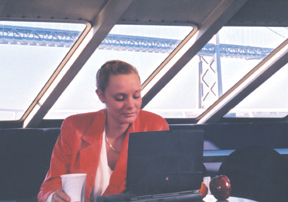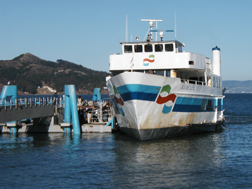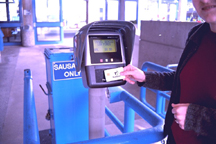
High Tech Comes to the High Seas:
Ferries Use Technological Advances to
Benefit Passengers and Operators
 |
| Harbor
Bay ferry passengers are able to enjoy the trip between Alameda and
San Francisco with uninterrupted access to the Internet! |
Back in the days of Bay Area native son
and writer Jack London (1876-1916), ferries unable to navigate the fog
routinely collided with other vessels and the shore. It’s no wonder these
collisions occurred when fog navigation meant nothing more than keeping a
close watch and sounding a whistle. After World War II (1945), radar was
available for boats in the Bay, showing the worth of technology by nearly
eliminating the number of collisions. Today, ferry operators are seeking
more than a safe ride for their passengers. Technology is being tapped to
make a more enjoyable trip for Bay Area ferry riders.
A model of success in making smooth
connections: Golden Gate Ferries were early TransLink® partners
An example of how technology is helping
commuters make smooth connections is TransLink®, which was
tremendously successful with Golden Gate Ferry riders. This "smart
card" allows transit riders to pay their fares for Bay Area buses,
trains, light rail lines, and ferries using a uniform device about the size
and shape of a credit card. Electronic card readers connect to the card’s
embedded microchip to deduct pre-paid amounts, leaving customers free from
the hassle of carrying cash and from having to produce exact change, passes,
or tickets specific to different lines of transit throughout the
region. The program is run by the Metropolitan Transportation Committee (MTC).
 |
| TransLink®
card: the first smart card of its kind in the U.S. that can be used
interchangeably from bus to rail to BART to ferry |
On February 1, 2002, MTC included the
Golden Gate Bridge Highway and Transit District (GGBHTD) in a pilot project
along with five other Bay Area transit providers. Other transit providers
participating in the early testing include AC Transit, BART, San Francisco
Municipal Railway, Caltrain, and VTA. The nine-county Bay Area distinguishes
itself as the first location in the U.S. to offer a single card that can be
used on all forms of public transit.
According to GGBHTD Public Information
Director Mary Currie, ferries were relatively easy to equip with TransLink®
because of the small number of ferry landings. Fewer
points of departure meant fewer card readers to install. TransLink® has
also been installed on a select number of GGBHTD buses. Ms. Currie said that
new customers eager to try TransLink® on their commute will have to wait
until MTC’s grand rollout of the system, expected to occur in late 2004;
MTC is not currently issuing new cards.
Russell Driver, MTC’s TransLink®
Project Manager, said that ferries were the most successful part of the
program thus far. Specifically, he cited the small number of devices that
MTC had to install at ferry landings and the ease of recruiting pilot
project participants by setting up a table at the San Francisco Downtown
Ferry Terminal. The cost of developing TransLink® to date: $25 million,
which includes the costliest component, software development.
Ms. Currie said that lessons thus far
learned included the need to accommodate various fare structures offered by
the transit agency, e.g., discounts for senior, disabled, commuters, and
youth. Apart from the value of customer convenience, she said that TransLink®
is streamlining the auditing process. Specifically, using an electronic fare
process is an ideal tool for ease of auditing, which GGBHTD must do on a
regular basis.
 |
| Golden
Gate ferries were among the first transit agencies to participate in
a pilot project testing the TransLink® smart card |
The closest highway equivalent to
TransLink® may be the Fast Track lanes offered at Bay Area bridge toll
crossings, including the Golden Gate Bridge, allowing cars to pass through
without having to stop and pay. Instead, the toll is automatically deducted
from an electronic device mounted on the inside of the car’s windshield.
The Fast Track program was implemented about two years prior to the
inception of TransLink®. According to Ms. Currie, it’s been very popular,
with 65 percent of drivers crossing the Golden Gate Bridge currently using
Fast Track. The beta test for TransLink® is still underway, and capped at
200 ferry users. Already, those riders account for nearly 10 percent of the
total farebox revenue. Ms. Currie is hopeful that TransLink® use will grow
as rapidly as Fast Track has grown since its Millennium inception on the
Golden Gate Bridge. Approximately 65 percent of Golden Gate Bridge users
beep their way past electronic toll collection using Fast Track.
Although the Bridge District cites
financial challenges as a barrier to adopting additional new technology, Ms.
Currie says that they are hoping to add more customer-friendly applications
in the future. In particular, the District is eyeing GPS tracking that will
let customers know when to expect the next ferry or bus.
For now, happy customer Jorge Shulz, a
member of the Golden Gate Ferry Passenger Advisory Committee who commutes by
ferry between Larkspur and San Francisco, reports, "The ferry makes
commuting fun. TransLink® makes it easy." Mr. Shulz has been commuting
via ferry for 20 years and immediately signed up for TransLink® when it
became available because it seemed to make perfect sense. He has
successfully used TransLink® to transfer after landing by ferry in San
Francisco to his next trip down the Peninsula via Caltrain. He is looking
forward to the time when BART is also fully online with the TransLink®
program, saying that having to purchase an additional BART ticket "is a
hassle. Integration [of this program] is ideal so that there is no need to
worry about ticketing and money."
A Floating Home Office: Alameda-Harbor Bay
ferry passengers are first ferry passengers in the world to make use of
wireless Internet during their commute
Staying connected to information and
e-mail messages has become an important part of life for many people who can’t
afford to miss opportunities to do so. Now, passengers on Harbor Bay ferry
have an extra reason to travel between Alameda and San Francisco via ferry;
using this mode of transit allows them uninterrupted access via wireless
internet (WiFi). Although WiFi has become a staple product offered in many
cafes, this is its first maritime application.
 |
| A
single swipe with one universal card is all it takes for TransLink®
users to go from one transit line to the next |
If the example set by the availability of
wireless internet access on Alameda’s Harbor Bay ferry line proves
successful, Desmond Wheatley, Enterprise Network Solutions’ Managing
Director, which installed and designed this application
for marine use, predicts that every boat on the water will soon have it.
This unique product, which allows passengers to connect their handheld
devices or laptop computers to the Internet, operates through a cleverly
designed system of a tower, a variety of antennaes, radios, and a switch
router. Thus, there is no need to attach a computer to any type of phone or
DSL cord to gain access to the Internet. Passengers are free to roam about
the boat at will.
Laptops built within the last year have WiFi capability
built into them; earlier models can be equipped with a wireless card which
will allow the laptop to pick up a signal. Passengers can either tap into
their existing service provider accounts or sign up for Harbor Bay Internet
service provider for a fee; and the connection speed on board Harbor Bay
ferry is twice as fast as most DSL. According to Mr. Wheatley, tech savvy
Bay Area ferry passengers offered a round of applause when his company
enabled wireless internet service on their vessel.
Mr. Wheatley said, "All boats have a requirement of
some sort of data transmission. The current choices, such as VHF radio and
cell phones are limited by bandwidth. This technology [wireless internet]
offers 50-60 times faster transmission than cell phones. That’s the
difference between a garden hose and the Alaska pipeline!" Thus,
similar to TransLink®’s dual benefit for customers as well as for
accounting purposes, ferry operators will have double incentive to install
wireless internet: to satisfy existing regulations.
Mr. Wheatley added that his company is developing
applications for the technology that will allow cameras to use the same
network infrastructure to monitor what’s going on in the boat. "For
instance," he said, "you’ll be able to tell whether someone
other than authorized personnel is in a restricted area." Enterprise
Network Solutions has equipped 63 shopping centers with a similar setup that
allows tracking and monitoring of missing children.
A typical character in a Jack London novel found himself
facing desperate situations, such as being stranded in the snow or fighting
the seas to stay alive. With the convenience of today’s technology, those
characters could easily call for help or query the Internet for survival
tips. But, a more likely scenario: today’s technology provides modern
passengers with an enticement to take public transit by making it more
convenient than ever.